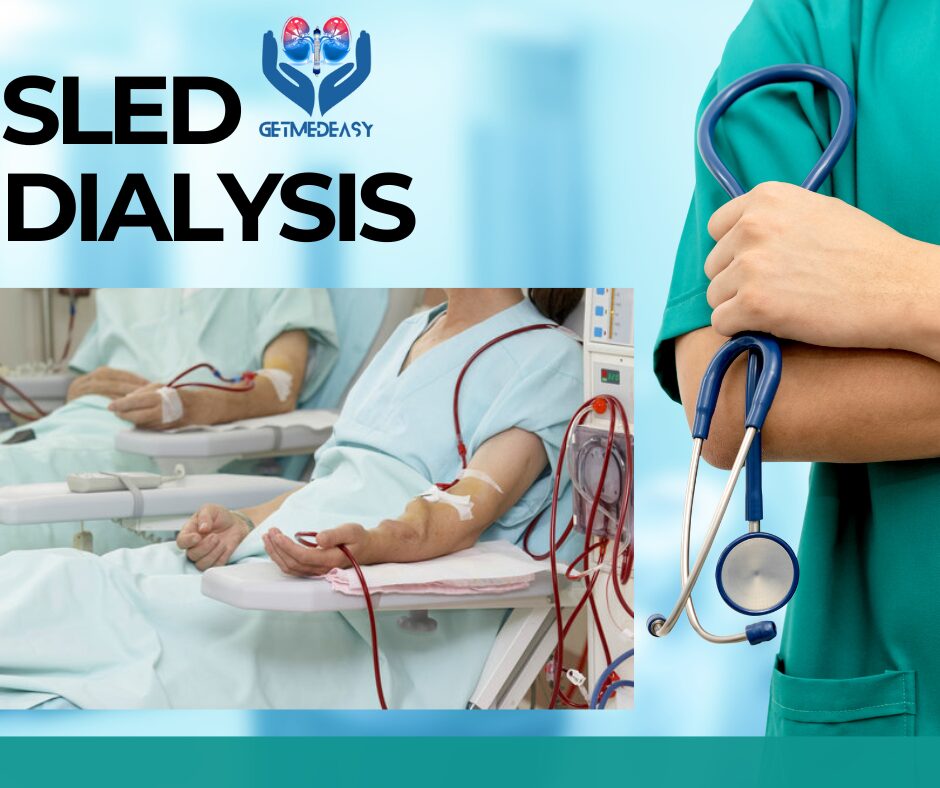What is SLED Dialysis?
SLED dialysis, or Sustained Low Efficiency Dialysis, is a renal replacement therapy commonly used in critically ill patients, especially those in Intensive Care Units (ICUs) with acute kidney injury (AKI). It is a hybrid method that combines the best features of intermittent hemodialysis (IHD) and continuous renal replacement therapy (CRRT).SLED is performed over an extended period—typically 6 to 12 hours—using standard dialysis machines, but at lower blood and dialysate flow rates. This slow and gentle approach reduces the risk of hemodynamic instability in patients who are already very ill.
How Does SLED Dialysis Work?
SLED uses conventional hemodialysis equipment but modifies settings to ensure lower efficiency over a longer time. Key parameters include:
- Blood flow rate: ~100–200 mL/min
- Dialysate flow rate: ~300 mL/min
- Treatment duration: 6–12 hours
- Frequency: Often daily or every other day, depending on clinical need
This approach is ideal for ICU patients with unstable blood pressure or multi-organ failure.
Who Needs SLED Dialysis?
SLED is often recommended for:
- ICU patients with acute kidney injury (AKI)
- Patients with sepsis or multi-organ failure
- Patients who cannot tolerate rapid fluid shifts from standard hemodialysis
Those with limited access to CRRT due to equipment or cost
Benefits of SLED Dialysis
✅ Gentler on the Heart: Lower blood flow rates reduce strain on the cardiovascular system.
✅ Better Fluid Control: Prevents drastic fluid shifts, reducing the risk of hypotension.
✅ More Efficient than CRRT: Removes toxins more effectively than continuous methods.
✅ Cost-Effective: Requires fewer resources than CRRT.
Who is SLED Dialysis Best For?
SLED is ideal for:
✔ Critically ill patients (e.g., sepsis, multi-organ failure).
✔ Hemodynamically unstable patients who can’t tolerate standard HD.
✔ Patients needing gradual toxin removal (e.g., severe electrolyte imbalances).
Risks and Limitations of SLED
⚠ Longer Treatment Time: Requires extended sessions compared to HD.
⚠ Not for Outpatients: Typically used in hospital ICUs, not home dialysis.
⚠ Requires Specialized Equipment: Not all dialysis centers offer SLED.
SLED vs CRRT vs IHD – Key Differences
| Parameter | SLED Dialysis | CRRT | Intermittent HD |
| Duration | 6–12 hours | 24 hours continuous | 3–5 hours |
| Flow Rate | Low | Very low | High |
| Equipment | Standard HD machine | Specialized machine | Standard HD machine |
| Hemodynamic Effect | Stable | Very stable | Risk of instability |
| Cost | Moderate | High | Low |
Conclusion
SLED dialysis offers a balanced approach for patients who need gentler but efficient toxin removal without the intensity of standard hemodialysis. While it’s mostly used in critical care settings, ongoing research may expand its applications.
If you or a loved one has kidney disease, consult a nephrologist to see if SLED dialysis is a suitable option.



